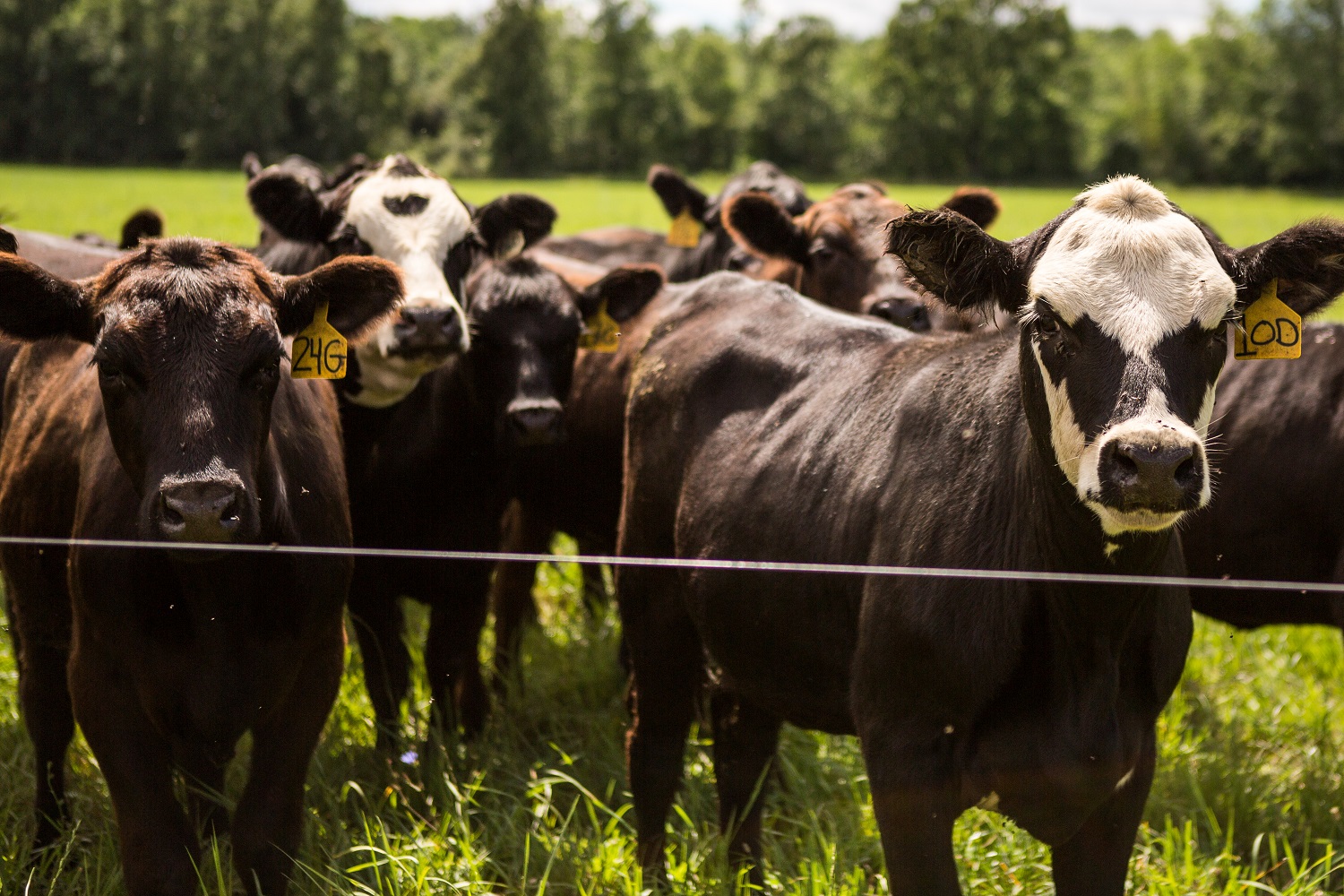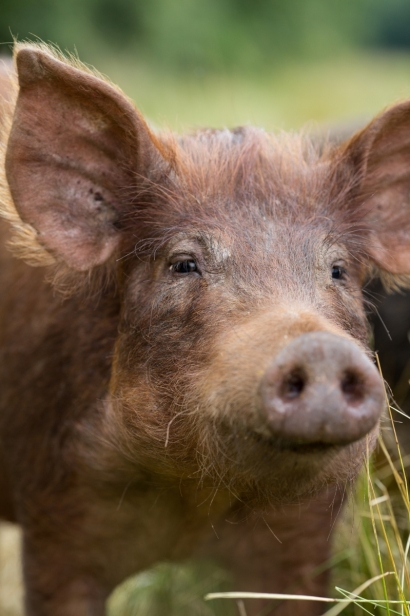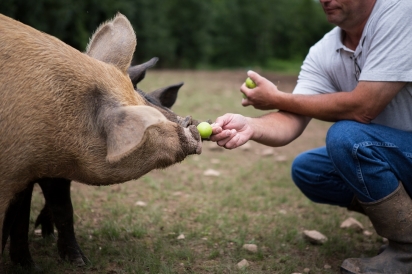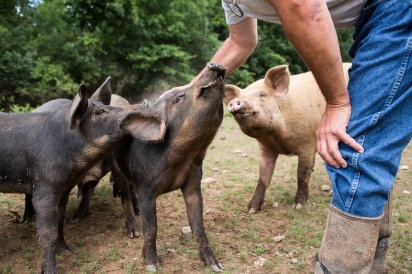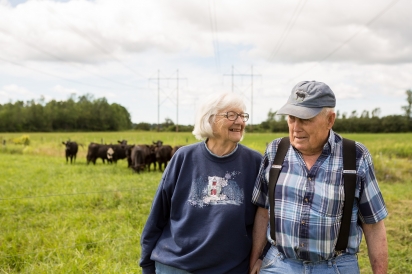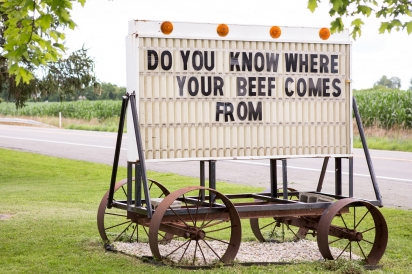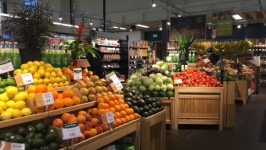Regionally Raised and Grazed
Editor’s note: Since this story went to print, Rich Tilyou decided to retire and close T-Meadow Farm. The pigs were sold to Kindred Kreek in Akron, NY where they join a large farm family of alpacas, cows, sheep, chickens, turkeys, rabbits and goats. Kindred Kreek Owner Jeff Jendrowski echoed the benefits and challenges of raising local meat expressed in the article, especially those posed by a lack of slaughterhouses in the region.
The benefits and challenges of local meat farmers
Who knew there were so many things to consider when buying a pork chop?!
In 2017, being mindful of the food one puts into one’s body seems as natural as the act of eating itself. There are many layers to this mindfulness; eating food—particularly animal protein—is a financial, dietetic and political act.
Some buy only the cheapest meat in order to stretch their dollar, regardless of nutritional value or purity. Others purchase only the highest quality, which usually has the highest price tag. Many try to balance the two extremes by selecting better quality meat but consuming less of it, either by eating a smaller amount during a meal or choosing vegetarian substitutions for typically meat-centric dishes.
Not too long ago, an overarching concern was the effect meat could have on one’s weight, and the worry that it was “fattening.” Consumers selected meat such as poultry over beef or pork for its perceived healthier benefits. Many continue to eat less meat with the belief that it is better for health, but newer concerns also tend to revolve around wholesomeness instead of merely calories, fat and protein.
Perhaps the most charged aspect is eating (or not eating) meat because of the societal impacts of supporting industrial meat. From well-publicized environmental concerns to those related to the treatment of animals, the commercial meat industry is under critical scrutiny, both internally and from politicians and customers.
This is important because, when given the choice, many consumers vote with their dollars, supporting options that align with their ethics and worldview. The food industry is taking notice. When McDonald’s starts field-testing organic meat, it’s not a stretch to think that something important is afoot.
For consumers interested in positively impacting their local economies, the choice is clear. Buying one’s meat from a farm that’s closer to home has many consequential benefits.
“Somewhere between three and four times more capital gets recirculated within the local region where that purchase is happening,” says Andrew Delmonte, president of Buffalo First, a non-profit whose mission includes education and advocacy surrounding regional economic development issues. “That’s substantial. Three to four times is a lot of money that stays here rather than getting siphoned out, largely being sent to the headquarters or the shareholders of whatever large or multinational company we’re talking about.”
Buying local also underpins one’s connection to the community, and there is added value in knowing the person who provides your food.
“Just by virtue of a farm being closer, you might have a much better chance of speaking to the farmer, hearing more about their practices and what actually goes into the product,” Delmonte adds. “If you’re not sure which large-scale farm across the country the meat actually came from, it’s a lot harder to check up on practices and that sort of thing.”
And it goes beyond the fact that the meat is raised nearby. Having many purveyors of meat instead of a few big ones allows consumers more choice. Different breeds are raised for various attributes. Large-scale commercial operations tend to raise breeds that gain more muscle and less fat in a shorter amount of time. That, in combination with the economy of scale, allows companies to make more profit and get their product to market with a lower price to the consumer.
Therein lies the challenge for local meat farmers.
“Some of the prices that I see for commercial pork—94 cents a pound, 98 cents a pound. It costs me $1.50 a pound just for the package!” says Rich Tilyou of T-Meadow Farm in Lockport.
So, if a local farmer can’t compete on cost, his or her unique selling proposition is the ability to raise breeds with desirable traits. For example, the hogs that Tilyou raises are generally better in the cold climate of Western New York than their commercially raised, grain-fed cousins. Because they like to forage, their meat has a deeper flavor and more texture. This makes them a favorite of local chefs and markets. However, it’s more expensive to raise his animals in this way and that means a higher price.
“To get a commercial hog up to market weight, which is 225 pounds hanging weight, will take five and a half or six months,” he explains. “Whereas on the pasture, it’s going to take nine to 10 months. With some breeds, it might take a year to get them up to that weight. It’s definitely more expensive, there’s no question.”
A science teacher in the Niagara-Wheatfield Central School District, Tilyou grew his 97-acre farm into a business after first purchasing four hogs to help clear overgrown vegetation. At its peak, the farm had about 200 heritage breed Gloucestershire Old Spot and Tamworth hogs. Currently, that number is at 100-120 animals. He adds that more farms are popping up to provide local beef, lamb, pork and poultry.
Another challenge to continued growth of local meat is the bottleneck that happens due to the lack of slaughterhouses in the area. According to Tilyou, three have closed down since he started his operation, and only one new one has opened up. He attributes the decline to the difficulty of the work, the expense and regulations.
“I really wish that somebody young and energetic would open up a facility, maybe one for poultry and one for red meats,” he suggests. “Definitely, there is room.”
As with all businesses, ideally a local farmer provides food but can at the same time make money—or at least not lose money. That means adjusting. For example, Tilyou raised chickens to sell as meat birds. Because of the cost of processing, it did not make business sense to continue. Now, T-Meadow Farm sells pork to restaurants and markets exclusively. Also, while he enjoyed selling at farmers’ markets, he stopped because it spread his resources too thin.
Even though she and her husband are well past retirement age, Judy Librock of Librock Farm in Gasport says still she enjoys the interaction of the farmers’ markets. Judy and Walt “Sonny” Librock both grew up on dairy farms and ran their own 100-Holstein dairy until about 12 years ago. Because of the costs of modernization, and as their three children grew up and moved off the farm, they chose to ramp down the dairy operation.
They transitioned to raising grass-fed beef cattle on their 200 acres prompted by their grandson and a 4-H project. After an initial purchase of six cows, the operation now sustains about 50 or 60 Black Angus cattle a year. They currently sell to customers directly and at farmers’ markets.
“When you milk dairy cows, you put the milk in the tank and tanker comes, picks it up and takes it away. You don’t have any connection with the people that are using your product,” Librock explains. “This way, we are actually talking to the people and the people are telling us how good it is. That is very satisfying!”


